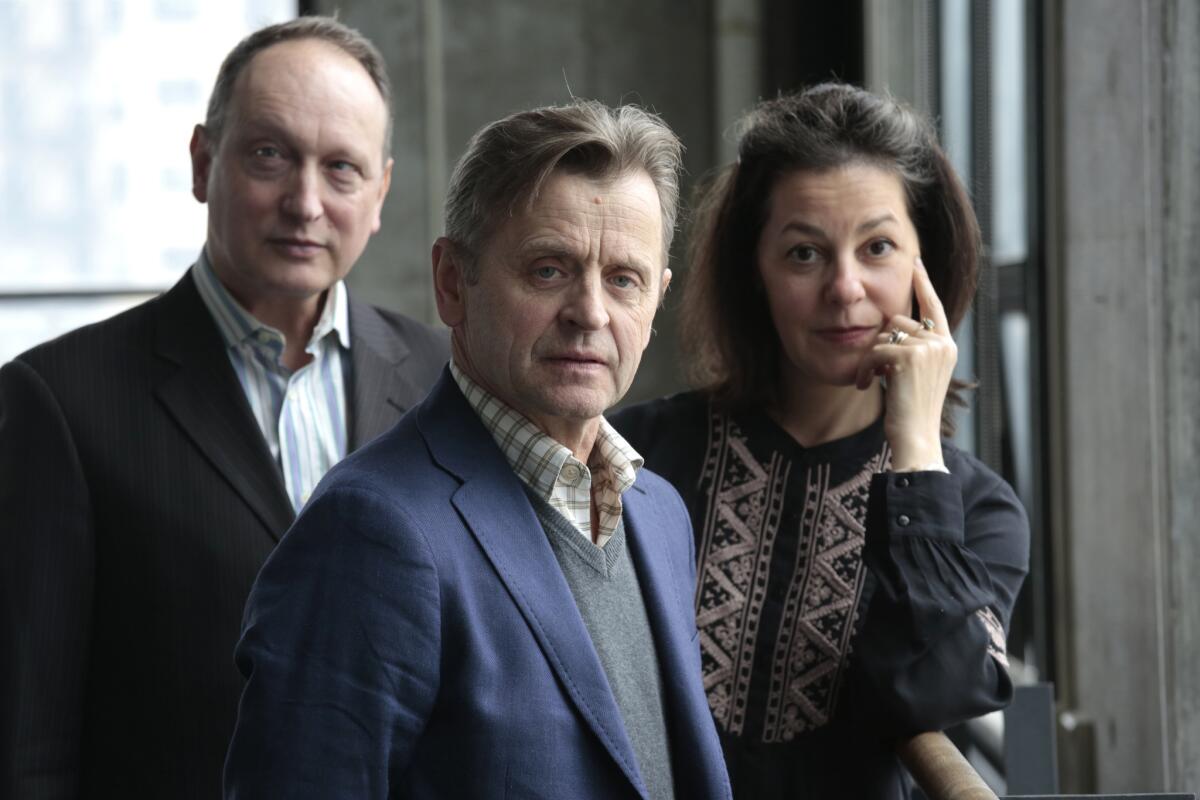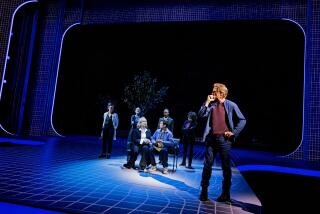Mikhail Baryshnikov makes a ‘Case’ for restless creativity

NEW YORK — Mikhail Baryshnikov’s earliest experience in the theater began when he was a child of just 4 or 5 in present-day Latvia, then a part of the Soviet Union. His mother, a Russian speaker unfamiliar with the local tongue, would drag along her young son to play interpreter.
Now, after a career in dance, film and television, he’s performing the title role in “Man in a Case,” a multimedia adaptation of two short stories by Anton Chekhov running April 24 through May 10 at the Broad Stage in Santa Monica.
It’s merely the latest dramatic adventure for the dancer, who began to dabble in a side career as an actor shortly after defecting to the West and shooting to international celebrity in the mid-1970s. He earned an Oscar nomination for his role in 1977’s “The Turning Point” and later starred with Gregory Hines in “White Nights” and Gene Hackman in “Company Business.” Most memorable, at least to younger viewers, was his role as Aleksandr Petrovsky, Carrie Bradshaw’s maddeningly self-absorbed artist boyfriend, in the final season of “Sex and the City.”
PHOTOS: Arts and culture in pictures by The Times
Though the Hollywood TV and film roles continue — Baryshnikov recently popped up in a cameo in Kenneth Branagh’s “Jack Ryan: Shadow Recruit” — the dancer, who moved from roles in classical ballets “The Nutcracker” and “Giselle” to co-founding the modern White Oak Dance Project, has gravitated toward experimental theater since making his stage debut in Steven Berkoff’s “Metamorphosis,” adapted from the Kafka novella, in 1989.
“Maybe it was premature a bit, the reviews were very mixed, but I got the bug,” says Baryshnikov, known affectionately as “Misha” to friends and family, at the Baryshnikov Arts Center, a multidisciplinary performance space in Manhattan he opened in 2005.
In more recent years, he’s appeared in “Beckett Shorts,” a compilation of four short Samuel Beckett plays directed by JoAnne Akalaitis, and “In Paris,” based on a short story by writer Ivan Bunin, also seen at the Broad. While not all the productions have been critical favorites, Baryshnikov’s performances have generally earned high marks. Later this year, he’ll perform opposite Willem Dafoe in another literary adaptation, “The Old Woman,” at the Brooklyn Academy of Music. Adapted from the writings of Russian absurdist Daniil Kharms, the piece is directed by experimental pioneer Robert Wilson and originated last year at the Manchester International Festival.
PHOTOS: From screen to stage: Musical movie adaptations
“I’m just fascinated by the theater, especially avant-garde theater,” Baryshnikov says. “You have to connect certain dots which are not on the surface necessarily connected. I just love the opportunity to go onstage and make a fool of myself willingly.”
“Man in a Case” premiered last year at Hartford Stage in Connecticut and has since played in Berkeley and Washington, D.C, receiving favorable to glowing reviews (“Mesmerizing,” according to the San Francisco Chronicle).
Baryshnikov, 66, likens his foray into theater to former President George W. Bush’s newfound passion for painting, but as far as late-in-life pastimes go, Baryshnikov could certainly have chosen something less demanding than “Man in a Case.”
He’s onstage for nearly every minute of the play, which is based on two Chekhov tales of love thwarted by societal pressure. In the title story, Baryshnikov plays against type as Belikov, an officious small-town Greek teacher whose solitary, rigidly structured existence is thrown into disarray when he falls for a vivacious Ukrainian woman named Barbara (Tymberly Canale). In the shorter, second piece, based on “About Love,” he is a highly educated but indebted farmer madly in love with a friend’s wife, again played by Canale.
PHOTOS: Best in theater for 2013 | Charles McNulty
“As different as they are, there’s something fundamentally shared by those two characters. To me they stand in precise contradiction to Chekhov’s primary dictum, which is ‘live now,’” says Paul Lazar, who adapted and directs, with Annie-B Parson, under the auspices of their company, Big Dance Theater.
“Man in a Case” began its journey to the stage when Baryshnikov, commissioned by Hartford Stage, approached Parson and Lazar about collaborating on a solo dance piece. The conversation quickly moved to Chekhov.
Baryshnikov had recently read “The Man in a Case,” one in a trilogy of interconnected stories published in 1898, and was struck by its immediacy.
“The subjects, the characters are familiar pretty much to everyone,” he says. “The insecurities and longings and all those things are utterly modern, like it was written today. That’s why this author is quite amazing.”
Lazar and Parson, who are married, immediately sparked to the material.
CRITICS’ PICKS: What to watch, where to go, what to eat
“The allure of the piece for me was imagining Misha in the center of it,” says Lazar, noting how Belikov, a man who refuses to dance, is the opposite of Baryshnikov, and yet he’s someone who is defined by his physicality. They quickly decided to pair it with another story from the trilogy, “About Love,” and to borrow Chekhov’s framing device, hunters sharing stories around a dinner table. (The roles are performed by actors from the company.)
While the husband-and-wife team hadn’t been planning to adapt Chekhov, they were no strangers to his work. Lazar, a prolific character actor whose film credits include “Silence of the Lambs” and “Beloved,” spent years touring as part of the Wooster Group’s “Brace Up!,” a re-imagining of Chekhov’s “Three Sisters,” and in 2011 starred in another adaptation of the play with Peter Sarsgaard.
But taking on a piece as familiar as “The Sea Gull” or “Uncle Vanya” was never in the cards for Big Dance Theater. Lazar and Parson rarely use traditional plays as source material, preferring texts less burdened with expectations and allowing for greater interpretive freedom. “It’s almost like plays are done,” Parson explains. “What we do is so different, it’s nice to have something that exists in one form, like a story, and then we have to figure out how to make it into a play or a dance.”
PHOTOS: Hollywood stars on stage
Baryshnikov shares Lazar and Parson’s aversion to adapting “big, traditional pieces.”
“You have to take a much more conventional approach because it’s kind of fragile material,” he says. “The big plays are done by everybody, from the small theaters to big festivals with Cate Blanchett. I am interested more in theater of today.”
Using a multimedia style that incorporates dance, video, music and inventive sound design, Lazar and Parson have staged literary works by Flaubert and Twain as well as found texts, like Nixon’s White House Tapes.
Their version of Chekhov is neither a slavish period piece nor a straightforward contemporization but something in between: The costumes and set design allude to fin de siècle Russia as well as the present day.
“I am completely allergic to Chekhov plays where people are wearing 19th century clothes,” Parson says. “I literally don’t think I can see one again. I like Chekhov so much, I feel like that gets in the way of my experience.”
PHOTOS: The most fascinating arts stories of 2013
In keeping with Big Dance’s signature style, “Man in a Case” is a layered piece that weaves together dialogue from the Russian master’s original text (and even a few lines from “Three Sisters,” for you Chekhov scholars) with surveillance footage, instructional videos and choreographed movement. The eclectic mix of music, live and some recorded, spans Russian folk songs to ‘80s Carly Simon. Yes, Baryshnikov even dances (a little), but theatergoers hoping to see him pirouette across the stage will be disappointed.
In something of a rarity for an actor, Baryshnikov is reluctant to talk about his process.
“When you read something about how somebody has approached roles in this and that, it’s embarrassing,” he says with a roll of the eyes. He’s more at ease reflecting on how his years as a dancer have informed his dramatic work.
“My instinct pretty much always leads me out of trouble, whether it’s a dance or an experience in the theater,” he says. “Sometimes I don’t necessarily know what to do, but I always know what not to do.”
More to Read
The biggest entertainment stories
Get our big stories about Hollywood, film, television, music, arts, culture and more right in your inbox as soon as they publish.
You may occasionally receive promotional content from the Los Angeles Times.










